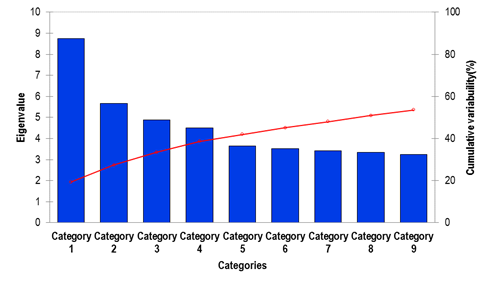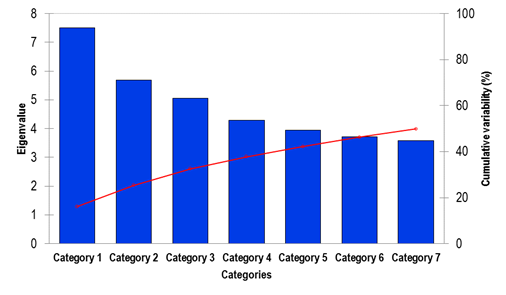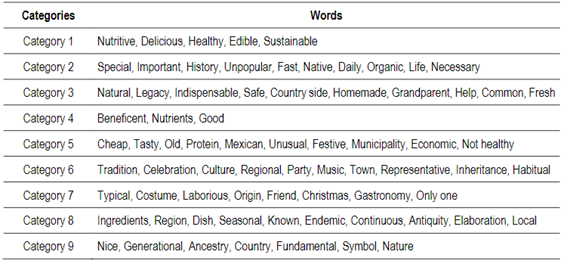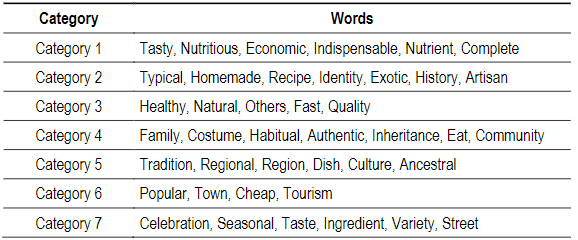1. Introduction
Food not only provides nutrients and energy, it also fulfils social and cultural roles. In addition, foods represent the know-how linked to a geographical region that gives it a symbolic character, derived from the cultural heritage of individuals1)(2. On the other hand, “in its acquisition there are factors that intervene such as: the origin of the product, the manufacturing process, linked to territories, functionality and ethical values”3.
Due to this, the analysis of values, concepts and/or images that a person has about a food is essential for the understanding of the behavior of individuals towards a food. The representation of a concept symbolizes the knowledge that a social group has developed over the years and transmitted generationally, through actions and/or practices, which forms a specific way of understanding reality and relating to its environment4. In this sense, the representation that a group of people has about a food, particularly when it is a product associated with a geographic region, is decisive when it comes to eating behavior5.
Rozin6 points out that culture is decisive in food choice. To some extent, the influence of culture is reflected in the type of diet, the portion size, as well as the season and the context in which a food should be consumed1)(7. A general tendency to define a culture is to consider nationality or country. However, within the same country there may be subculture, that is, groups of cultures that live within a society and have adopted variants of the general model of culture8. In addition, each culture is linked to a specific geographical context, as well as agricultural systems and techniques of products produced9. In this sense, Mexico is one of the countries with the greatest cultural diversity in the world10. An example of this is the state of Hidalgo, where 51% of the population lives in rural areas and 12% of the population is indigenous11. In addition, this state features ten geocultural regions, with various edaphoclimatic11, cultural and economic conditions, of which the Mezquital Valley and Comarca Minera region stand out.
The Mezquital Valley is the largest geocultural region in Hidalgo. Most of the population of this region belongs to the Otomí ethnic group, calling themselves Hñähñu; hñä (to speak) and hñü (nose); that is, those who speak the nasal language or those who are bilingual. One of the elements is their traditional gastronomy, which is the combination of indigenous and Spanish elements, and is characterized by the use of resources and ingredients present in the environment, reflected in the dishes and beverages9. In the case of the Comarca Minera region, it is one of the most important territories of Hidalgo. This region is considered the gastronomic route of the state. Its gastronomy is the most representative, the result of industrial and mining activity. In addition, their gastronomy is characterized by having a European influence, introduced in the 1800s12.
Despite this diversity, there are no studies analyzing the conceptual representation of the concept of traditional food. This becomes important in the study of food behavior and the attitude of consumers towards traditional foods, especially in populations that differ in their cultural profile. In this sense, this work was aimed at analyzing the conceptual representation of the term “traditional food” of the inhabitants of the Mezquital Valley and the Comarca Minera region.
2. Materials and methods
2.1 Participants
The study was carried out in municipalities that make up the Mezquital Valley and the Comarca Minera region in Hidalgo, Mexico. The inclusion criteria for willing participants were being from one of the two regions and being over 18 years old.
2.2 Free word association test
The participants were interviewed individually, and were told that there were no correct or incorrect answers. The term “traditional food” was employed as a stimulus, and participants were given an evaluation sheet where they were asked to write down three words that came to their minds when they heard “traditional food”. To carry out the test they were given 45 seconds. According to Guerrero and others5, the time restriction allows verifying the ease of associating words to the stimulus in question. In addition, it is possible to recover the most immediate thing that comes to the mind. Therefore, the meaning and symbols associated with the concept can be defined13. Finally, after the word association exercise, participants were asked to provide socio-demographic information (gender, age, occupation, income), the percentage of their spending on foods, and the origin of the food they consume.
2.3 Data analysis
Researchers who participated in the study reviewed the words generated in each region. Spelling errors were corrected and for words with synonyms by using a dictionary14, the most frequently mentioned synonym was selected. Then, the words mentioned in each region were counted. The levels of diversity and rarity were calculated following the proposal of Rodrigues and others15. According to this approach, the diversity index is the relationship between the number of words (T) and the total number of words associated with the stimulus (N). When there are values close to 1, it will reflect a maximum of diversity. The rarity index reflects the percentage of words mentioned only once and is called Hapax (H) divide by the number of different words. The data were organized to be analyzed using a Chi-square test (p<0.05) in order to establish possible significant differences between regions.
For grouping words and establishing the dimensions constituting the meaning of the concept within each region, Latent Semantic Analysis (LSA) was carried out. LSA is an unsupervised algorithm that allows the extraction of conceptual relationships (latent factors) between terms and/or documents. LSA is based on a linear technique known as singular value decomposition, from which a vector representation of the corpus or semantic space is generated, which results in capturing the main semantic “dimensions” that constitute the corpus. LSA is based on two linguistic assumptions about meaning: meaning is contextually dependent and in contextual use, there are latent semantic similarity relationships16 with which it is possible to solve the problem of synonymy and polysemy. In addition, establishing the correlation of the words that are used will allow to establish the semantic similarity between the concepts analyzed from the co-occurrence with which they are used under certain verbal contexts16)(17. The algorithm consists of four stages:
1) Concept matrix: A matrix is generated where the columns are concepts of interest and lines are in this case people who mentioned the concepts. Each cell contains the frequency with which each concept was mentioned. The order of appearance or mention of the words is not considered in the representation matrix.
2) Matrix transformation: Instead of working with the frequencies of raw concepts, the inputs in the matrix are often transformed. The best performance is possible to be observed when frequencies are accumulated in a sublinear way (typically log (freq ij + 1)), and inversely with global occurrence of term in the collection (typically an inverse frequency of a concept or an entropy-based score).
3) Dimension reduction: A reduced rank singular value decomposition (SVD) is carried out in the matrix, in which the largest singular k values and the remainder are set to 0. The resulting dimension reduction is the representation from best k-dimensional approximation of the orginal matrix in the least square sense. Each concept is now represented as a k-dimensional vector in space as a result of the SVD.
4) Recovery in reduced space: Similarities are calculated between entities in reduced dimensional space, instead of the original concept matrix. Because both concepts are presented as vectors in the same space, similarities between terms are relatively easy to calculate. In addition, terms can be compared in the same way. For example, to find similar concepts in a search, a new search vector is formed at centroid (weighted average) of its constituent vectors, and then compared to word vectors to find similar concepts. This process by which new vectors are incorporated into LSA space is called folding. The cosine or angular distance between vector is used as a mesure of their similarity for may information retrieval applications, since it has been proven effective in practice18.
Once the words associated with the concept “traditional food” were analyzed in each region, a matrix of concepts was generated, where columns were concepts mentioned and lines were the participants. When the concept was mentioned by a participant, the cell contained 1, and when the concept was not mentioned, the cell had 0. To carry out the grouping of concepts a fixed grouping strategy was chosen, that is, a mentioned concept could only belong to a single semantic group or dimension (which represents the best semantic axis). Subsequently, a consensus among the researchers formed the definitive semantic categories. All the analyzes were performed using the statistical software XLSTAT ver. 2021 (New York, USA).
3. Results and discussion
A total of 267 people were interviewed -138 in the Mezquital Valley and 129 in the Comarca Minera region. When comparing socio-demographic characteristics between regions, it was observed that the level of economic income per month, the food expenditure and the food preparation were the characteristics that presented significant differences (Table 1).
Table 1: Socio-demographic characteristics of participants in each region expressed as a percentage
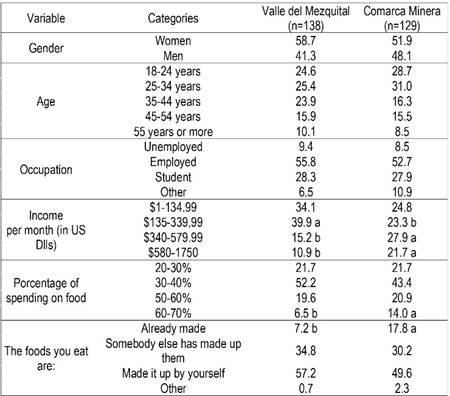
Letters in each column indicate significant difference according to the K proportions test (p <0.05)
Regarding the level of income, the Comarca Minera region featured a greater diversity of income than the Mezquital Valley. In addition, the Comarca Minera region had a higher percentage of people who indicated that they received monthly incomes of $135-339 and $580-1,750, compared to the Mezquital Valley. This result indicates that in the Comarca Minera region there is a greater economic capacity in the part of its inhabitants than in the Mezquital Valley. Regarding the percentage of spending for the purchase of food, it was also observed that in the Comarca Minera region there is a higher percentage of people who spend between 60 and 70% of their income on food, which would confirm the differences between the two regions in terms of income. Likewise, it was observed that there is a higher percentage of people in the Comarca Minera region who buy their food already made.
3.1 Number of elicited words
The Mezquital Valley participants had a total of 410 associations, which represent an average of 2.97 associations per participant. In the case of Comarca Minera region, a total of 386 words were elicited, that is an average of 2.99 words associated with the concept “traditional food”. The results of both geocultural regions reflect that the participants under restrictive conditions of time have verbal fluency, which is related to semantic knowledge, part of long-term memory, where the recognition of objects, facts, as well as the meaning of words are found5. Based on these results, participants from both regions would be familiar with the concept of “traditional food”. When comparing the Mezquital Valley and the Comarca Minera region, no differences were observed in the number of words (χ2 (1)=0.510, p=0.475); type of words (χ2 (1)=0.437, p=0.508) and Hapax (χ2 (1)=0.028, p=0.867). In relation to Diversity Index the values were: 0.44 for the Mezquital Valley and 0.49 for the Comarca Minera region. Finally, for the Rarity Index, both regions had 0.33.
In accordance with Rodrigues and others15 for Diversity Index values of less than 0.50, in this case it suggests that in both regions the diversity of words related to the concept “traditional food” would be low, that is, in both cases the defining words would be confirmed by a group of defined terms. Regarding the Rarity Index, the values are relatively high, as mentioned by Rodrigues and others15, that is, the words mentioned once are high in both regions. This particular result suggests that there is an idiosyncratic tend in both regions, as a result of a heterogeneity in the experiences of the participants around traditional foods. Based on the observed results, it seems that whitin each region there is a defined set of words, within a high idiosymcratic tendecy, that define the concept of “traditional food”.
3.2 Latent Semantic Analysis
When analyzing the total number of words generated in both regions using Latent Semantic Analysis, nine categories were generated to group the words mentioned in the Mezquital Valley (Figure 1), and seven categories in the case of the Comarca Minera region (Figure 2).
In the case of Mezquital Valley, the nine categories explain just over 50% of the variability of the information. For the Comarca Minera region, the seven categories explain 50% of the variability. These results reflect a measure of the quality of the projection that the Semantic Analysis performs at the time of carrying out the reduction, so in both cases it is inferred that the quality of the reduction is adequate. Appendix 1 and 2 show the most frequently mentioned terms in both regions. In the case of the Mezquital Valley, nine different categories were necessary for the categorization of the most mentioned words; on the other hand, for the Comarca Minera region, seven different semantic categories were required. However, some categories presented different words that could be classified in the same category.
Derived from the review of the first analysis and the categories formed, through a consensus between the researchers who participated in the study, new semantic categories were generated. For the Mezquital Valley, four new semantic dimensions were generated; while for the Comarca Minera there were three new dimensions (Tables 2 and 3).
Table 2: Final semantic dimensions for the “traditional food” concept definition in the Mezquital Valley
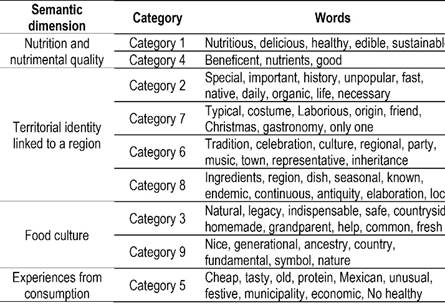
Table 3: Final semantic dimensions for the “traditional food” concept definition in the Comarca Minera
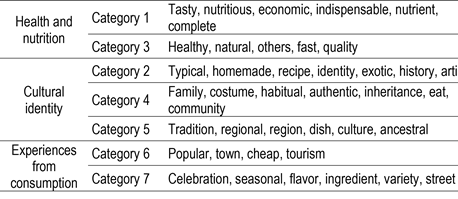
The semantic dimensions are different in both regions. In the case of Mezquital Valley, the representation is made up of four semantic dimensions: nutrition and nutrimental quality, territorial identity linked to a region, food culture and experiences from consumption. For the Comarca Minera region the concept representation consisted of three dimensions: health and nutrition, cultural identity and experiences from consumption.
The nutrition and nutritional quality dimensions would reflect the potential of traditional foods in relation to health and natural. This could be related to a low degree of industrial processing, which would suggest a perception of nutritious food with health benefits, due in part to the way it is prepared19. Guerrero and others5 mention that the perception of a healthy product is derived from a little processed “natural” preparation through which the food is prepared, which at conceptual level is decisive for the definition of the concept.
According to our results, the territorial identity linked to a region is important on the definition of the “traditional food” concept. The relationship of traditional product with a region, in addition to a quality attribute, has a symbolic and emotional meaning for consumers20, which seems to be confirmed in this work. Also, traditional foods are related to history, to who we are and what we belong to, that is, identity, according to the geographical and cultural context. Therefore, the consumption of traditional foods is conditioned by their meaning, both at family level and collective. In this sense, Muchnik21 indicates that “people in society integrate food as a component in the construction of their identities”. The merger of categories three and nine resulted in the dimension “food culture”. In this sense, Rozin6 mentions that within each culture there are norms, principles and values that influence the choice, preparation and specific season in which foods are consumed, especially those considered as “traditional”. Within each culture there are agricultural systems and practices that contribute to the elaboration of food according to a region. Likewise, the consumption of traditional foods is a strategy for preserving what is considered to be typical of a culture, especially when it comes to social groups with a defined identity and linked to a geocultural area, as would be the case of the Otomi population.
The importance of the dimension “experiences from consumption” lies in the fact that the consumption experience of individuals is familiar with the sensory characteristics of food, and to differentiate them, especially when it comes to traditional foods, in addition to learning the context in which it is consumed. As pointed out by Trichopoulou and others22, who mention that this potential can be built as time passes, derived from the experiences of consumption, which influence when making a judgment.
Our results suggest that in Mezquital Valley region there are four dimensions that form the definition of the “traditional food” concept. Contrary to this, in the Comarca Minera region, three semantic dimensions make up the concept of “traditional food”. It is important to mention that both regions presented three similar dimensions, however, the “food culture” dimension for the Mezquital Valley is a function of the cultural context related to the environment. In other words, the edaphoclimatic conditions in the area lead the population to relate food to its environment, whether for nutritional, medicinal, festive, and religious purposes. However, the Comarca Minera region, an increased urbanized region, is characterized by having a European-influenced diet where the majority of the population have economic access to buying their food. Therefore, it can be said that consumption of traditional foods, from the cultural point of view, is heuristic and contains certain elements related to what mankind produces. Specifically, in the production of food through the metepantle (concept from Mexican pre-Hispanic agriculture), the orchard family complemented with hunting and gathering, that is, an agri-food culture. What represents values, local knowledge, meaning customs and traditions at social level.
On the other hand, although it is true that Guerrero and others23 found that the “traditional food” concept is made up of seven dimensions in the European context, in the Latin American context the definition is made up of four dimensions, of which only the “territorial identity linked to a region” coincides with the dimension of those authors. Therefore, and according to these results, the dimensions that make up the concept of “traditional food” based on latent semantic analysis, in a geocultural context such as the Mezquital Valley and the Comarca Minera region, are partially different, and are related to historical and cultural context of the territory. That is, in each region, traditional foods are a gastronomic landscape, relate to social, political, cultural, economic or historical factors24)(25. In this way, gastronomy is intangibly associated with a specific place and its food; this includes landscapes, heritage, history, tradition, structures and social relationships26.
4. Conclusions
Through the association of words and the latent semantic analysis, the dimensions that define the concept of “traditional food” were obtained in the context of the inhabitants of Comarca Minera region and Mezquital Valley. Latent semantic analysis is an adequate tool for the management of concepts, especially when it seeks to define the meaning of terms from the perception of people, as was our case. In the state of Hidalgo, Mexico, the concept of traditional food is related to the dimensions of health and nutrimental quality; territorial identity linked to a region; food culture, and experiences from consumption. Even when we speak of the same state, there were cultural differences associated with the concept between the regions. One of the differentiating semantic dimensions between regions was food culture, which reflects the uses, customs, history and elaboration of traditional foods, which are determined by the productive systems and the agricultural strategies in the context of each biocultural region. These results are useful for understanding people's behavior towards traditional foods, what would allow the rescue and revaluation of traditional foods in a context of innovation and wellbeing for the populations of interest.














